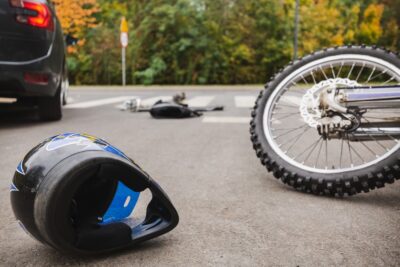
Every motorcycle rider knows the dangers of taking a spill without the proper protective gear. But what happens when your helmet is involved in an accident – is it still safe to wear? This is an important question many riders face after experiencing a crash, regardless of whether injuries were sustained.
While helmets are designed to help shield our heads, the forces involved in even minor collisions can compromise a helmet’s integrity in unseen ways. As Atlanta motorcycle accident lawyers, we understand the desire to get back on the road as soon as possible.
However, damaged helmets should never be overlooked, as their capacity to safeguard your brain is only guaranteed when fully intact. Sometimes, a fresh new lid is absolutely necessary for safe riding.
How Helmets Protect Your Head
To understand why helmets need replacing, it’s important to understand how they are built and how they function. Here is an explanation of how motorcycle helmets work:
Motorcycle helmets are designed to protect the rider’s head during an impact or accident. They work in a few key ways:
Shell
The shell is the first line of defense against impact. The outer shell is hard and durable, usually made of plastic, carbon fiber, fiberglass, Kevlar, or some variety of composite. Its job is to deflect and distribute impact forces away from the head.
EPS Layer
The Expanded Polystyrene Layer is immediately beneath the exterior shell. A multi-density EPS cushion in high-quality helmets is made to compress when the helmet is hit. An essential function of this compression is to deflect the impact force away from your head by soaking up its energy. A vast number of lives are spared daily because of this crucial component.
Inner Liner
At the innermost layer of the helmet lies the comfort padding and retention system. This is what keeps your helmet securely in place on your head and provides a comfortable fit. The padding not only adds comfort but also helps absorb sweat and moisture while riding.
Chin Strap
The retention system, typically consisting of straps and adjustable buckles, ensures that your helmet stays put even during sudden movements or impacts.
Get the strong arm
The Helmet After a Crash
During a crash, the helmet undergoes significant changes in its structural integrity that may not be immediately visible to the naked eye. The compressive forces generated upon impact cause the layers of the helmet to come closer together, potentially affecting their ability to effectively absorb and disperse the impact energy.
Even if there is no visible damage on the outside of the helmet, it is essential to understand that the EPS liner, a crucial component in absorbing impact energy, may have been compromised.
This means that in subsequent crashes or impacts, the helmet may not provide adequate protection due to its reduced ability to cushion and protect the head. Even minor crashes on grass or dirt can impact the integrity of the helmet. This is why it’s so important to replace your helmet after a crash, no matter where the motorcycle accident happens.
Are There Other Times I Should Replace My Helmet?
It is recommended by the Motorcycle Safety Foundation to replace helmets every couple of years to ensure they are in good condition. Helmets can deteriorate over time due to exposure to various factors, and signs of wear and tear, such as fraying chin straps or damaged shells, indicate the need for replacement.
Regular inspection and following replacement guidelines can ensure the helmet’s effectiveness in protecting the rider’s head during a crash.
Can a Motorcycle Helmet Be Defective?
Motorcyclists can sustain injuries when thrown from their bikes, and the causes can include faulty bike components and safety gear like helmets.
Helmets should have a DOT sticker on them and should meet the design and safety standards set by the U.S. Department of Transportation (DOT). Cheap helmets might not offer enough safety in the event of an accident.
Can I Sue the Manufacturer of a Defective Helmet?
A product liability action against the distributor or manufacturer of the motorcycle helmet is within the realm of possibility. If you want to know if you have a case for damages, you should photograph images of the helmet shortly after the accident, save the whole helmet or at least its parts, and put them somewhere safe where they won’t get damaged.
The rider may face a more uphill battle in a lawsuit if the helmet wasn’t DOT-approved, as these helmets aren’t meant to be used on street motorcycles. Your claim for a defective helmet is more likely to be successful if the helmet has been approved by DOT and is regulated by the CPSC standards.
Even while helmet safety regulations are in place on a national level, faulty helmets can nevertheless find their way into circulation. Until a biker sustains a brain injury, it is sometimes impossible to determine whether the helmet was defectively constructed or produced from subpar materials.
Please call our office to schedule a no-cost consultation so that we can examine your situation in more detail.
Contact Us Today for a Free Case Evaluation if You’ve Been in a Motorcycle Accident
Whether due to an accident, normal wear and tear, or unknown defects, motorcycle riders must prioritize helmet safety by properly inspecting their helmet and replacing it as needed.
While the desire to save money and get back on the road quickly is understandable, nothing beats a helmet in preventing catastrophic head injuries. At John Foy Personal Injury Law, our team of Atlanta motorcycle accident attorneys is here to ensure riders’ rights are supported.
If you have questions about helmet defects or accident responsibilities or need guidance after sustaining injuries, please don’t hesitate to contact us. We offer free case evaluations to victims and their families.
404-400-4000 or complete a Free Case Evaluation form



